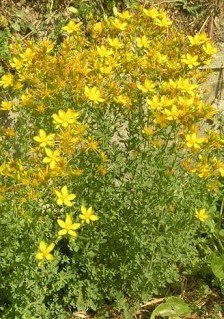Area
Steppe species grow on roadsides, ditches, meadows, meadows, forests, forest edges, among bushes. Mainly Ukraine, Belarus, Moldova, the Baltic genera, the European part of Russia, and the forest, forest-desert zone of western Siberia, the Caucasus, and Central Asia.
Botanical description of the plant
Hole field - Hypericum Perforatum L. and spotted (quadrangular) dalachoy - Hypericum maculatum Crantz. (Hypericum quadrangulum L.); steppe - belongs to the family Hypericaceae.
Steppe species is a perennial herb, reaching 30-100 cm in height plant. The rhizome and root are abundant. Stems several, erect, smooth, hairless, angular, the upper part is oppositely branched. Bargioddi y, elongated-ovate, flat-edged, oppositely banded at the base located. The flowers are golden yellow, segmented, clustered in a thyroid gland. The fruit is a three-chambered, multi-seeded pod that opens when ripe. The seeds are small, elongated and concave, painted brown. It blooms in June-August

Medicinal properties
Medicinal products of the product wrinkle, antiseptic and has a rapid healing effect on wound tissue. In medicine it is used in the treatment of diseases of the gastrointestinal tract (colitis, diarrhea), diseases of the oral cavity (gingivitis and stomatitis), as well as II and III degree burns, as well as for rinsing the mouth. The surface of the plant has a bactericidal effect. Medicinal products. Tincture, tincture, liquid extract, bactericidal drug novoimanin, peflavit (the sum of catechins is released in Bulgaria in tablet form, has a vitamin R effect). Novoimanin is a dark brown powder (powder) containing 0.5-1% solution in water, a mixture of alcohol and water with glycerin, and in the form of powder (powder) and ointment for simple, purulent wounds, burns, scabs and other purulent processes. used for treatment. Oily extract of Dalachay plant (Dalachay oil) is used in the treatment of gastrointestinal ulcers.
Growing technology
Hole field is a perennial herb, mainly from seed multiplied. Before planting, the soil is plowed to 25-28 cm in the fall. Before driving, 20-25 tons of manure per hectare and 50 kg of superphosphate fertilizer are applied. In order to grow high yields from the field, in early spring the top layer of soil is well buried seeds, normal germination and it is necessary to loosen it in such a way as to create favorable conditions for its development, to improve air circulation, to ensure moisture penetration into the seed from the lower layers, and to focus on weed control. In early spring, the soil is leveled before planting, and the growing annual weeds are lost. In late March and early April, the seeds are certified in vegetable seeders with a row spacing of 60 cm and seeds at a depth of 0.5-1 cm planted. Since the seed is very fine, it is sown by mixing it with sand (1:50). 4-5 kg of seeds are used per hectare. Its seeds can germinate after 12–16 days at 5–6 ° C. But the seeds are faster than the ground It is desirable that the soil temperature at emergence was 18–20 ° C. If the holes are sown in the fall, they are in early spring develops faster and yields than seeds sown in spring will be high. It is because the grass of the plant is delicate cleaned of weeds and quickly cultivated between rows softened. If the plant is thick, it is done alone and 10 plants are left on 1 m of land. In the first year the plant is watered 10-12 times, row spacing is loosened by 4-5 times cultivation and 3-4 times interval between manual weeding. 40 per hectare during growth kg of nitrogen, 30 kg of potassium fertilizers are given. Feeding the plant is done before watering. In June and July, when the field is in full bloom, the above-ground part of it is harvested by hand with the help of silo-wrapping mechanisms, the flower branches of which do not exceed 30 cm.
The raw material is quickly dried in special devices. After the first harvest, for good plant growth, the field is fed with ammophos fertilizer from 80-100 kg per hectare of planted area. After 30-40 days, the field can be harvested a second time. Its yield may be even higher than in the first harvest. Dalachoy does not bear fruit in the first year. In the early spring of the second year, the fields were cleared of plant debris and irrigated longitudinally and transversely with nitrogen, phosphorus and potassium fertilizers fed. On average, 3-4 tons of raw materials and 500-600 kg of seeds can be harvested from each hectare of land if the seedlings are stored, fed, watered and cleared of weeds.





